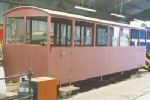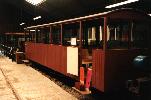Coach No. 8
‘Gladstone’ Car
From its construction in the 1870s, the North Wales Narrow Gauge Railways (NWNGR) operated a collection of four and six wheeled carriages. After 1891, new bogie coaches, fitted with continuous Westinghouse brakes, were purchased. This was a most useful selection of stock, a decade ahead of all other narrow gauge railways, with even the Ffestiniog Rly making a poor showing by comparison.
No. 8 was constucted by the Metropolitan Carriage and Wagon Co. Ltd. of Brimingham. It was classified as a 'Tourist Carriage', one of the first attempts to encourage tourist travel on any narrow gauge railway in Britain. It recognised the attractions of open balconies yet having somewhere to retire to when the weather turned unfavourable. The central all-glazed saloon was curtained, upholstered and carpeted. Automatic central couplers with safety chains were fitted, as well as lighting and those small appointments which place a vehicle in a class of its own. It was liveried in cream upper works and white roof, with the customary Midland red waist. The lettering and lining was in gold-shaded vermilion. The roof was repainted grey sometime later. Each door had a class number (‘1’) on it, together with 'N.W.N.G.Ry' and the vehicle number. For good measure, No. 8 had the Company's Arms on a plaque mounted on the side.
Mr. Gladstone, the Prime Minister, travelled in No. 8 on the way to a holiday at Nant Gwynant. Thereafter, the coach was nicknamed the 'Gladstone Car'.
By 1922, No. 8 had received a vermilion red livery. Under WHR/FR management, No. 8 was renumbered No. 29 in 1922. Sometime between 1923 and 1934 it may have received a new livery of FR Kentish Green, along with the rest of the carriage stock. However, at closure, the stocklist gave the colour as red.
The body of the Gladstone Car was located many years ago by members of the Festiniog Railway in a garden near Harlech. It was deemed to be beyond restoration and various fittings were removed for re-use (quite possibly they are on vehicles running on the FR today).
Some years later in 1989, the new WHR recovered the coach from a local field (see photo). One balcony was completely missing, but most of the rest was intact. An original builder's plate had survived the FR's stripping, but all other fittings are replacements. The original bogies were lost and restoration has involved fabrication of replacements to a completely new design to modern high precision standards.
Restoration is now complete, and the Gladstone Coach is in regular service. The Gladstone car was always a first class carriage, even though not designed as one originally. The centre compartment had 14 upholstered seats and had lighting and roof vents, cut off in WHR days for through-running on the FR. It is hoped, if money becomes available, that it be restored to its former Victorian splendour.
Specifications
| Number | 8 | ||
|---|---|---|---|
| Name | Gladstone Car | ||
| Type | Central glazed saloon, open balcony at either end | ||
| Builder | Metropolitan Carriage & Wagon Co. | ||
| Built | 1891 | ||
| Wheel arrangement | Bogie | ||
| Brakes | Air | ||
| Length | 26' | ||
| Width | 5' 6" | ||
| Seats | 28 | ||
| Arrived W.H.R. | 1989 | ||
| Owners | W.H.R. Ltd | ||






